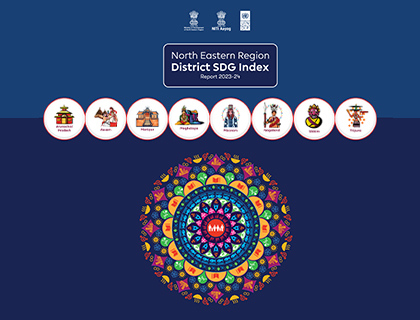Syllabus:
GS3: Inclusive Growth and issues arising from it
Context:
The second edition of the North Eastern Region (NER) District Sustainable Development Goals (SDG) Index Report (2023-24) was released today by NITI Aayog.
More on the News
- The NER District SDG Index 2023–24 is expected to serve as a vital policy instrument for guiding regional development efforts, particularly under flagship initiatives like the Aspirational Districts Programme.
- The Index is developed by NITI Aayog and the Ministry of Development of North Eastern Region (MoDoNER), with technical support from UNDP.
- The Index measures the performance of districts across eight North Eastern States on the SDGs.
- This is the second edition of the report and has come out after two years. The first edition was released in August 2021 and covered 103 of the 120 districts (86 percent).
- The index reflects the commitment to address development challenges across social, economic, and environmental dimensions while ensuring that no one is left behind in the NER.
- The latest data shows that 85% of the districts show increase in composite score.
About the Report
- The index, which covered 131 (92 percent) districts of the eight north-eastern states—measured their performance across 15 Sustainable Development Goals (SDGs) comprising 84 indicators.
- These include poverty, hunger, health, quality of education, gender equality, access to clean water and sanitation, clean energy, industry, innovation and infrastructure, economic growth, responsible consumption and production, among others.
- SDGs 14 and 17 are excluded because of their limited or no applicability at the district level.
- The districts have been ranked based on a composite score that ranges from 0 to 100 and denotes the district’s overall achievement in realizing the targets under the SDGs.
- A score of 100 implies that the district has achieved the targets set for 82 identified indicators; a score of 0 implies that the district is at the bottom.
- Based on the score, each district is categorised into one of the four categories:
- Achiever (when the score equals 100).
- Front Runner (when the score is between 65 and 100, excluding 100).
- Performer (when the Index score is between 50 and 65, excluding 65).
- Aspirant (when the Index score is less than 50).
Key Findings

- All districts in Mizoram, Sikkim and Tripura have achieved Front Runner status, with no districts falling in the Aspirant or Achiever categories.
- Mizoram has the highest-scoring district in the entire Northeast region (Hnahthial at 81.43) and Arunachal Pradesh has the lowest-scoring district in the entire region (Longding at 58.71).
- Sikkim has the narrowest range (5.5 points) in terms of the score of the highest and lowest district, showing the most consistent performance across its districts.
- Tripura has the distinction of having some of the highest-scoring districts with minimum intra-state variation (6.5 points).
- Mizoram and Nagaland have some of the highest-scoring districts but also exhibit variation (ranges of 13.72 and 15.07, respectively).
- The report also noted that 93 districts showed improvement under SDG Goal 3 (Good Health & Well-being).

